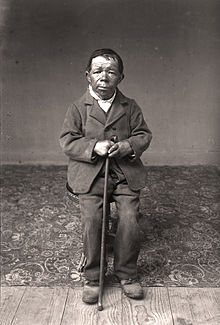User:Mr. Ibrahem/Congenital iodine deficiency syndrome
| Congenital iodine deficiency syndrome | |
|---|---|
| Other names | Congenital hypothyroidism due to iodine deficiency,[1] endemic cretinism,[2] fetal iodine deficiency syndrome[3] |
 | |
| A man with congenital iodine deficiency syndrome | |
| Specialty | Endocrinology |
| Symptoms | Intellectual disability, hearing problems, short stature, dry skin, poor coordination, strabismus, constipation[4] |
| Usual onset | Present at birth[5] |
| Duration | Long-term[5] |
| Types | Neurological, myxoedematous[5] |
| Causes | Mother or baby having iodine deficiency[4][6] |
| Prevention | Iodisation of salt[4] |
| Treatment | Levothyroxine[7] |
| Frequency | Rare (developed world)[8] |
Congenital iodine deficiency syndrome, previously known as endemic cretinism, is intellectual disability with either hearing problems or short stature as a result of endemic goiter.[4] Other symptoms may include dry skin, abnormal reflexes, poor coordination, strabismus, constipation, and voice changes.[4] A goiter may also occur.[4]
It occurs due to either the mother or baby having iodine deficiency due to insufficient dietary intake.[4][6] Onset is estimated to be 3 month to 8 months of gestational age.[5] The food cassave may also play a role.[5] It is divided into two types: neurological and myxoedematous.[5] Less severe cases may be labeled subclinical.[4] It is a type of low thyroid at birth (congenital hypothyroidism).[9]
Prevention is by treating iodine deficiency before people becomes pregnant.[4] Efforts include iodisation of all salt and iodized oil supplements.[4][5] Treatment involves the use of levothyroxine and iodine supplementation.[7][10] However; not all symptoms may be reversible with treatment.[7]
Congenital iodine deficiency syndrome is rare in the developed world.[8] In a population that is severely low on iodine, up to 10 to 30% of the population may be affected.[4] It was previously the most common cause of preventable intellectual disability.[4] The original term for untreated congenital hypothyroidism was "cretinism", which came into use in 1754 in Denis Diderot's Encyclopédie.[4][7] At that time it was common in Switzerland and Northern Italy.[4]
References[edit]
- ^ "ICD-11 for Mortality and Morbidity Statistics". icd.who.int. Archived from the original on 1 August 2018. Retrieved 22 June 2022.
- ^ "ICD-10 Version:2019". Archived from the original on 2020-03-31. Retrieved 2022-05-29.
- ^ "MalaCards integrated aliases for Fetal Iodine Deficiency Disorder:". www.malacards.org. Archived from the original on 20 October 2017. Retrieved 22 June 2022.
- ^ a b c d e f g h i j k l m n Chen, ZP; Hetzel, BS (February 2010). "Cretinism revisited". Best practice & research. Clinical endocrinology & metabolism. 24 (1): 39–50. doi:10.1016/j.beem.2009.08.014. PMID 20172469.
- ^ a b c d e f g Eastman, Creswell J.; Zimmermann, Michael B. (2000). "The Iodine Deficiency Disorders". Endotext. MDText.com, Inc. Archived from the original on 17 June 2022. Retrieved 23 June 2022.
- ^ a b "ICD-10 Version:2019". icd.who.int. Archived from the original on 31 March 2020. Retrieved 22 June 2022.
- ^ a b c d Salisbury, S (February 2003). "Cretinism: The past, present and future of diagnosis and cure". Paediatrics & child health. 8 (2): 105–6. doi:10.1093/pch/8.2.105. PMID 20019927.
- ^ a b Fanaroff, Avroy A.; Miall, Lawrence; Fanaroff, Jonathan; Lissauer, Tom (12 February 2020). Neonatology at a Glance. John Wiley & Sons. p. 11. ISBN 978-1-119-51320-9. Archived from the original on 27 June 2022. Retrieved 22 June 2022.
- ^ "Congenital iodine deficiency syndrome (Concept Id: C3165526) - MedGen - NCBI". www.ncbi.nlm.nih.gov. Archived from the original on 27 June 2022. Retrieved 22 June 2022.
- ^ Dennison, John; Oxnard, Charles; Obendorf, Peter (25 September 2011). Endemic Cretinism. Springer Science & Business Media. p. 144. ISBN 978-1-4614-0281-7. Archived from the original on 27 June 2022. Retrieved 23 June 2022.
